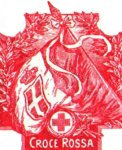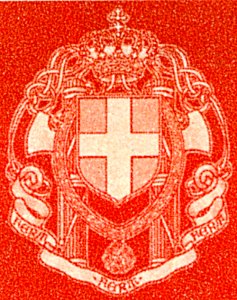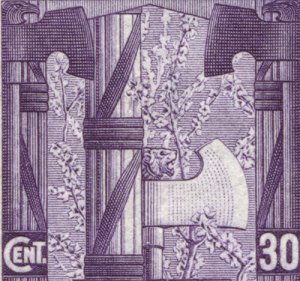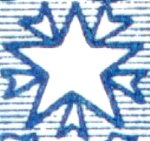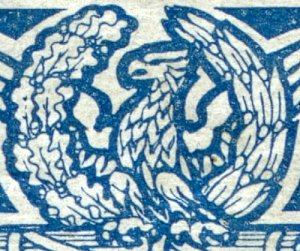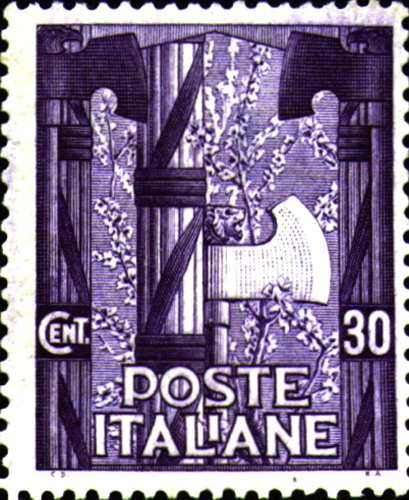|
Stamps of the Italian Social Republic
(1943-1945)
The past in the present. Italy
All photographs are subject to existing copyright laws.
High resolution copies may be obtained, subject to approval, by contacting:
Prof. Dr. phil.
Jørgen Christian Meyer
Department of Archaeology, History, Cultural Studies and Religion
University of Bergen
Norway
jorgen.meyer@uib.no
Ancient Studies, University of Bergen
|
Trude Meland and Jørgen Christian Meyer
Department of Archaeology, History, Cultural Studies and Religion
University of Bergen
Italy was one of the first countries in the world
to use stamps as a more conscious medium of propaganda. Most European stamps
up to the 1920's bear a portrait of the regent, coat of arms, occasionally
buildings of government or allegorical representations (France, Germany,
Switzerland, Spain and Portugal after 1912). Exceptions to this are a few
charity stamps (Belgium 1910, 1914, 1918, Austria 1914, Portugal 1915,
France 1917, Germany 1919), stamps commemorating sovereign's jubilee (Austria
1908, Holland 1913, Norway 1914, Liechtenstein 1918, Germany 1919-20),
Saints (Portugal 1895), world fairs (Belgium 1896-97), philatelist congresses
(Switzerland 1900), Olympic games (Belgium 1920), the victory after the
first world war (Belgium 1919, Switzerland 1919), important national poets
like Cervantes in Spain (1905) and two very early series from Portugal
with Henry the Seafarer (1894) and Vasco da Gama (1898).
Up to 1910 Italy did not differ fundamentally
from the rest of Europe. The main motives are the regent (Umberto and Victor
Emanuel) and coat of arms, which was common on ordinary stamps up to 1929,
where a new series was introduced. From 1910 onward the ordinary stamps
were supplemented with special series of limited period of validity and
impression, with a much more complex imagery. In 1910 two series were issued
commemorating the unification of Italy. The first one bears the portrait
of Garibaldi, the second one has different and rather complex allegorical
motives. In 1921 a small stamp with seal of the Republic of Trieste commemorated
the annexation of the city in 1921. National poets like
Dante (1921) and Mazzini (1922) were remembered. Charity stamps (1915-16,
1921-23), commemoration of the victory in 1918 and a series of Christian
propaganda stamps (1923), which are unique in contemporary Europe as to
size and colour, were issued, too.
The Fascist regime was quick to realize the propaganda
potential of the stamps, and from 1923 up to 1942 several series with a
more political message were issued in addition to the ordinary series.
The stamps are a valuable source to the history of the Fascist period as
a supplement to architecture and art. The motives of the stamps, as on
coins, are strictly controlled by a central authority, whereas the relationship
between art, architecture and the regime is much more complicated.
The purpose of this data base is not philatelic,
but historical. It presents all the series from 1862 up to 1942 with emphasis
on the symbolic representations in their historical context. Philatelic
details are only included if they are important from a historical perspective,
such as period of validity and impression.
SYMBOLS ON THE STAMPS
Tricolour.
The Italian tricoloure (green
next to the flagpole, white in the middle, and red at the fly end), modelled after the French tricoloure,
was first used in 1797 by revolutionary militiae in Modena.
The green colour replaced the French blue one, and it symbolized
liberty and equality.
When Napoleon in 1805 formed the Cisalpine Republic this state officially adopted the green-white-red flag.
The flag disappeared when Napoleon was overthrown, but it was revived when Victor
Emmanuel, King of Sardinia, and a representative of the House of Savoy,
became king. He added the arms of the Savoy, with the crown on the top, on the central white vertical band.
The Arms of Savoy or The Italian Royal Standard
The Italian Royal Standard or the Arms of
Savoy is composed of a central scutcheon decorated with a silver cross on red ground, with the royal crown on the top.
The scutcheon is surrounded by the pendant collar of the Order of Annunciation (Ordine della Santissima Annunziata).
The order was one of greatest chivalric orders of all times.
It was established in 1362 by Amedeus VI of Savoy.
The collar is composed of a series of knots, symbolizing unity, and roses.
To collar may be attached the letters F.E.R.T. meaning "Fortidudo ejus Rhodum
tenuit" (His firmness guarded Rhodes). This is a tribute to
Amadeus the Great (b.1249), the founder of the dynasty of Savoy. In
1310 he helped against the Saracens at the siege of Rhodes.
Another variant of the coat of arms is the black eagle with outstreched wings and a crown or star above the head. It carries the scutcheon on the breast.
The Italian coat-of-arms of the fascist period
Grouping together the arms of Savoy and fasces.
This combination is depicted for the first time on the Imperial series from 1929.
Fasces
A bundle of rods tied around the shaft of
an axe. In ancient Rome the fasces symbolized the authority of the superior magistrates. In the fascist period "fasces" were associated with "fascio", a political group or association. The fascist "combat teams" called themselves "Fasci Italiani Combattimento". In the fascist period the fasces symbolized both authority and unity. Several types of fasces are depicted on the stamps.
In the original Roman fasces the ax is placed halfway up the bundle of rods. During the French Revolution, where the fasces symbolized freedom, another type was introduced with the ax stuck up at the top. The fascists returned to the ancient Roman type, and often they placed the head of an eagle or wolf on top of the blade close to the rods. In some instances the ax was also placed at the upper or lower section of the rods.
The knot
The knot symbolizes "Unity".
The star
The star is often used in traditional allegoric
representations of Italy and symbolizes the good faith that protects Italy.
Laurel and oak
Oak leaves is a symbol of immortality or honour. Laurel is the symbol of the peace after victory.
ABBREVIATIONS
F.E.R.T.
"Fortitudo ejus Rhodum tenuit" (His firmness guarded Rhodes).
This is a tribute to
Amadeus the Great (b.1249), the founder of the dynasty of Savoy. In
1310 he helped against the Saracens at the siege of Rhodes.
S.N.D.A.
Societa Nazionale Dante Alighieri. (The National Society of Dante Alighieri).
The first society was founded in Italy in 1889 (Società Dante Alighieri/Societa Dantesca Italiana/Societa Nazionale Dante Alighieri). The purpose of the societies was philological, but it also had a political and cultural objective, which was exploited by the fascist regime.
After the Second World War the society was reorganized to dissociate it from the fascist past.
Also in other European countries societies were founded in the later part of the 19th century, in Germany already in 1865.
|
